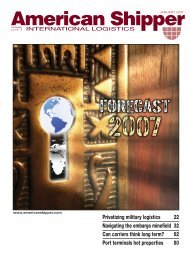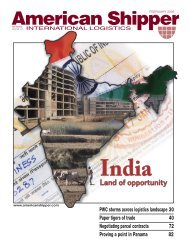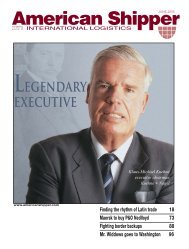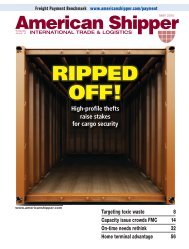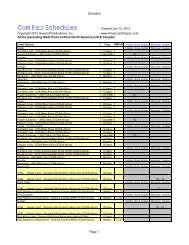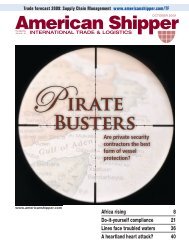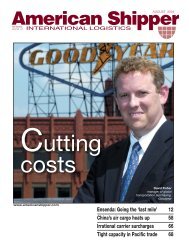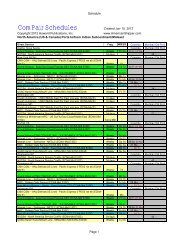graduate whom McLean hired in 1957 as his company’s firstmanagement trainee.Johns, who was president of Sea-Land Service Inc. from1979 to 1986, is currently chairman of Hampshire ManagementGroup, based in Roselle Park, N.J.“In the early days, he certainly didn’t say, ‘let’s get thiscoastwise deal up and running so I can go to Europe.’ All thathappened eventually occurred step by step,” Johns said.At that time, McLean learned a lesson from Eric Rath, a Miami-basednaval architect and engineer, who had put togethera fleet of several LST landing craft that he had converted intotrailerships.In 1954, Rath’s company, Trailer Marine Transport, beganoperating its vessels between Jacksonville,Fla.; Miami; and San Juan, Puerto Rico.Instead of building up a trading routebetween those venues, Rath sought todevelop transatlantic operations, and wentbankrupt.Crowley Maritime Corp. later boughtRath’s company, replacing its LSTs withmulti-deck barges and making the businessprofitable. That routing continues in 2006as part of Crowley Liner Services.McLean knew that it wasn’t enough toprovide a container service to Puerto Rico. It was also necessaryto have sufficient goods coming back to the United States sothe ships would not return empty.To that end, McLean hired William Neuhauser away from WallStreet to lure major U.S. firms, such as Johnson & Johnson, toset up offshore manufacturing plants in Puerto Rico that wouldgenerate valuable return cargo.Prior to the 1950s, about all Puerto Rico could send north wassugar and cement. Neuhauser was a prime catalyst in changingthat situation, as more <strong>American</strong> companies saw the sense ofestablishing Puerto Rican operations.“Bill Neuhauser made the Puerto Rican service more profitablefor McLean,” said David Howard, founder of <strong>American</strong> <strong>Shipper</strong>.“He never received the credit he should have for doing that.”Neuhauser’s recruiting of U.S. companies was similar to thehistoric British, Dutch and Scandinavian traditions of setting uphuge trading companies that would generate cargoes for shipsen route to national colonies.Yet McLean departed from this venerable European approachby having no financial involvement in the U.S. firms that expandedto Puerto Rico — just a favorable opportunity to bidfor their plant-to-plant freight.East Coast, West Coast beginningsOn April 26, 1956 — a grim, rainy day — about 100Pan-Atlantic employees and McLean’s invited guests assembledat Shed 154 in Port Newark to watchTantlinger’s bizarre-appearing retractingspreader lift 58 reinforced half-truck-sizedcontainers onto the 524-foot-long Ideal X,a tanker with a cargo deck.The truck trailers, which had beenseparated from their wheels and undercarriages,were more generally called “trailers”instead of “containers” at that time. LaterMarvin Barloon that day, the Ideal X sailed for Houstontransportation economist and, indisputably, into history.Pan-Atlantic’s first ship filled with cellguides to hold containers, the Gateway City, went into regularservice in the fall of 1957.Even as the Gateway City departed, there was lingering nervousnessabout how well container cells would work at sea.One naval architect predicted that the flexing of the vessel’shull would crush the containers in their confined cell guides. Yetafter a voyage from Port Newark to Miami, the containers werefound to have moved no more than five-eights of an inch.In 1957, Marvin Barloon, a transportation economist, wrotean article for Harper’s magazine called “The Second TransportRevolution” that had wide influence through the transportationindustry. Barloon clearly spelled out economic variances betweenrailroads and truck lines. “In 1929, the intercity truck lines movedonly two ton-miles of freight for every 50 carried by the railroads.“A ship which wouldnormally require four orfive days to load is packedwith trailers and out to seain eight hours or less.”In 1954 Eric Rath, a Miami-based naval architect, began operating a fleet of LST landing craft that he convertedto trailerships. Trailer Marine Transport served between Jacksonville, Fla.; Miami; and San Juan, Puerto Rico.16 AMERICAN SHIPPER: APRIL 2006
In 1955, they carried over 19 to therailroads 50 … year by year, thetrucks gain,” Barloon wrote.“Business once lost to the highwaysis hard to get back,” he said.“As a standard rule of thumb,goods can be moved eight mileson the deep waters at the same costas one mile by rail. But, becauseof high costs in the seaports, fivemajor intercoastal carriers werespending half of their total incomein 1953 in merely loading and unloadingcargo,” Barloon wrote.By using the method of carryinghighway trailers on vessels, “a shipwhich would normally require fouror five days to load is packed withtrailers and out to sea in eight hoursor less. On the Atlantic Coast, thecost of holding and loading a shipin port may run as high as $270 anhour, and the trailer-carrying vesselbrings down the loading cost fromhalf of the total revenue to some 2or 3 percent,” he wrote.Meantime, on the U.S. WestCoast, Matson Navigation Co.was vexed by high cargo-handlingcosts. As a consequence, Foster L.Weldon, an operations research expert,established an integrated research division within Matson.One of its first projects was to analyze how containerizationmight lower such costs.In 1958, Matson’s board of directors authorized $4 millionto be spent on the first phase of easing the company into containerization.Unlike Pan-Atlantic, whose vessels carried theirown cranes, Matson decided to build shoreside gantry cranes.Matson also opted for 24-foot containers, instead of McLean33-foot and later 35-foot boxes.By 1961, 40 percent of Matson’s cargo between the WestCoast and Hawaii moved in containers. That would rise quicklyto 65 percent.Stanley Powell, who became president of Matson in 1962 afterheading its freight division, recalled how doubters persisted onthe company’s board of directors. “They said containers wasteda ship’s capacity ‘by fillng it with boxes instead of paying cargo.’They said ‘all those boxes will create traffic jams in Hawaii.’When one director told me that I was 10 years ahead of mytime, I told him we had a board of directors that was a 100 yearsbehind the times and wanted to stay there,” Powell said.What saved containerization — and it was as true for Pan-Atlantic on the East Coast as well as for Matson on the WestCoast — was that “shippers really saw the advantages of thenew system quicker than anybody else,” Powell said.“In two more years, we didn’t have enough containers for thewhole trade and we were overwhelmed by cargo,” which endedonce and for all any dissent on Matson’s board of directors.Grace Line was the first shipping line to try to extend containerizationto international markets. Unfortunately, a VenezuelanPan-Atlantic’s vessels were outfitted with onboardcranes to load and unload containers.venture misfired badly due to laborproblems in South America. AfterUnited States Lines, the ranking<strong>American</strong> carrier on the EastCoast, spurned Grace Line’s offerof a joint transatlantic containerservice, Grace Line sold its firsttwo containerships to McLean.In 1960, Pan-Atlantic SteamshipCorp. changed its name toSea-Land Service Inc., a betterdescription of its operations.Recovering from their initialcaution, the board of directors ofU.S. Lines decided to timidly beginits venture into containerization.Ironically, both Sea-Land and U.S.Lines would subsequently engagein a 20-year rivalry to dominateU.S.-flag container shipping internationally.McLean would shapethe success of one company andthe ruin of the other.On March 18, 1966, a U.S. Linesfreighter called <strong>American</strong> Racersailed for Europe from New York.One of four ships designed withoversized main hatches to allowthe easy installation of below-deckcontainer cells, the vessel carried206 TEUs, 102 of them in the twomain hatches and the remainder on deck.U.S. Lines was the first carrier to enter the U.S./North Europemarket using ships with cells designed for containers. The companywas also the first carrier to adopt 40-foot containers, which soonbecame the international standard, along with 20-foot boxes.Vision and discipline“Good people lift you up,bad people lift you out.”Malcom McLeanSea-Land, from 1960 until 1969, was a company that reflectedMcLean’s vision and his sister Clara’s practicality.“McLean was very much part of the company on a workinglevel,” said Charles R. Cushing, whom McLean hired in 1961as Sea-Land’s mechanicalengineer.After six months,Cushing became thecompany’s naval architect.Today, Cushingis president of C.R.Cushing & Co. of New York, a firm of naval architects, marineengineers and transportation consultants.“Shortly after I started working at Sea-Land, McLean cameby and introduced himself — which he always did with newemployees,” Cushing recalled.“Anyone could talk with him about problems and ideas. Hewanted to hear from people at the floor-plate level,” he said.“Malcom used to come to Boston — my territory was the SouthShore of Boston — and he asked me to drive him to ProvidenceAMERICAN SHIPPER: APRIL 2006 17



